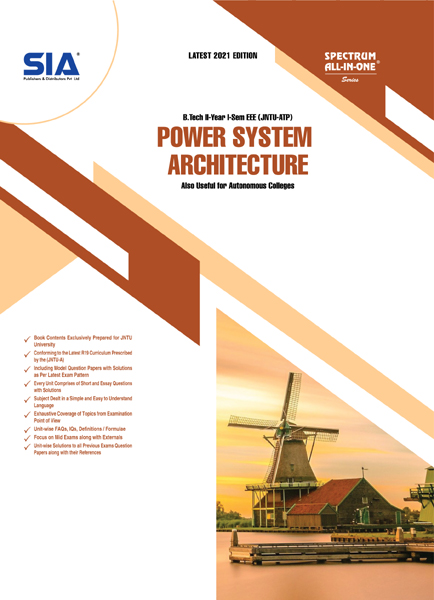

Note: Please check your Spam or Junk folder, in case you didn't receive the email with verification code.
SYLLABUS
Unit-1
CONVENTIONAL POWER GENERATING SYSTEMS Thermal Power: Block diagram of thermal power station (TPS), Brief description of TPS components Hydro Power: Selection of site – Classification – Layout – Description of main components. Nuclear Power: Nuclear fission and chain reaction – Principle of operation of nuclear reactor – Reactor components: Moderators – Control rods – Reflectors and coolants – Radiation hazards: Shielding and safety precautions – Types of nuclear reactors.
Unit-2
NON CONVENTIONAL POWER GENERATING SYSTEMS Solar Power Generation: Role and potential of solar energy options, Principles of solar radiation, Solar energy collectors, Different methods of energy storage – PV cell – V-I characteristics. Wind Power Generation: Role and potential of wind energy options, Horizontal and vertical axis wind mills – Performance characteristics – Pitch and yaw controls – Economic aspects. Biogas Power Generation: Principles of bioconversion – Types of biogas digesters – Characteristics of Bio-Gas – Utilization – Economic and environmental aspects. Geothermal and Ocean Power Generation: Principle of geothermal energy methods of harnessing – Principle of ocean energy – Tidal and wave energy – Mini hydel plants – Economic aspects.
Unit-3
TRANSMISSION LINE PARAMETERS Types of conductors – Calculation of resistance for solid conductors – Calculation of inductance for single phase and three phase – Single and double circuit lines – Concept of GMR and GMD – Symmetrical and asymmetrical conductor configurations with and without transposition – Calculation of capacitance for 2 wire and 3 wire systems – Effect of ground on capacitance – Capacitance calculations for symmetrical and asymmetrical single and three phase – Single and double circuit lines – Numerical Problems.
Unit-4
MODELING OF TRANSMISSION LINES Classification of transmission lines - Short, medium and long lines and their models - Representations - Nominal-T, Nominal-p and A, B, C, D Constants – Mathematical solutions to estimate regulation and efficiency of all types of lines – Long transmission line – Rigorous solution – Evaluation of A,B,C,D constants – Interpretation of the long line equations – Representation of long lines – Equivalent T and Equivalent-p, Numerical problems – Surge impedance and surge impedance loading – Wavelengths and velocity of propagation – Ferranti effect, Charging current – Need of shunt compensation.
Unit-5
GENERAL ASPECTS OF DISTRIBUTION SYSTEMS Classification of distribution systems – Comparison of DC and AC and under-ground and over-head distribution systems – Voltage drop and power loss in D.C distributors for the following cases: radial D.C distributors fed at one end and at ends (equal/unequal Voltages) – Uniform loading and ring main distributor – LVDC distribution network – Design considerations of distribution feeders: radial and loop types of primary feeders, feeder loading; basic design of secondary distribution – Voltage drop and power loss in A.C distributors.
 No Preview is available for this book
No Preview is available for this book

 Get 100 instant uPoints on the purchase of Rs.100 or above for each order.
Get 100 instant uPoints on the purchase of Rs.100 or above for each order.
CategoriesEngineering

Format EPUB

TypeeBook